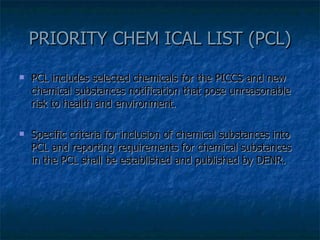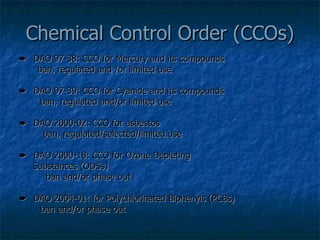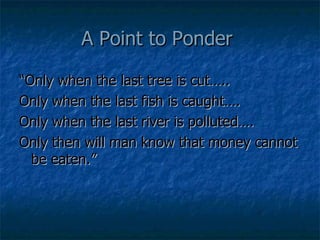cwa
- 1. Overview and Updates on Environmental Laws of the Philippines By ENGR. ROWENA M. AQUINO
- 2. The Philippine Environmental Laws (1987 Philippine Constitution) Executive Order No. 192 designated the Department of Environment and Natural Resources (DENR) Environmental Management Bureau (EMB) is specifically tasked to implement, recommend, and provide technical assistance for their implementation and monitoring
- 3. Philippine Environmental Law Environmental Impact Statement System P.D. 1586 Pollution Control Law P.D. 984 No projects shall be implemented without an Environmental Compliance Certificate (ECC) Provides permitting requirements Provides penalty provisions Provides Air and Water Standard
- 4. Clarification on the Scope of the Philippine EIS System. Simplification of Requirements for Securing ECC. Streamlining of Procedures. Strengthening the Implementation of the Philippine EIS System Environmental Impact Statement (EIS) System DAO 2003-30
- 5. Scope of the EIS System Project/Undertaking Covered ECC Category A Category B Not Covered CNC Category C Category D Category A – Environmental Critical Projects (ECP) Category B – Projects located in Environmentally Critical Areas (ECA) Category C - Projects enhancing environmental quality or address existing environmental problems Category D – Projects not falling under other categories or unlikely to cause adverse environmental impacts
- 6. Documentary Requirements & Processing Time Project Description or Proof of Project Implementation prior to 1982 Project Description PEPRMP EPRMP (based on a checklist if available) IEE or IEE Checklist (if available) EPRMP Programmatic EPRMP EIS Programmatic EIS DOCUMENTS REQUIRED FOR ECC APPLICATION 60 days EMB Regional Director Single Project B-1: New B: Projects located in an ECA 90 days EMB Central office Director Single Project 120 days DENR Secretary Co-located Projects A-2: Existing and to be expanded (including undertakings that have stopped operations for more than 5 years and plan to re-start, w/ or w/o expansion A-3: Operating without ECC 60 days EMB Central Office Director Co-located Project 30 Days EMB Regional Director Single Project B-2: Existing and to be expanded (including undertakings that have stopped operations for more than 5 years and plan to re-start, w/ or w/o expansion) B-3: Operating without ECC 15 days EMB CO or RO Director D. Not Covered 15 days EMB Regional Director Co-located or Single Projects C: Environmental Enhancement or Direct Mitigation 120 days DENR Secretary Single Projects 180 days DENR Secretary Co-located Projects A-1: New A: Environmentally Critical Projects MAXIMUM TIME TO GRANT OR DENY THE APPLICATION & DECIDING AUTHORITY APPLIED TO CATEGORY
- 7. Amending an ECC Major Amendment Expansion of land/project area Increase in production capacity Major change/s in process flow or technology Minor Amendment Typographical error Extension of deadlines for submission of post-ECC requirement/s Extension of ECC validity Change in company name/ownership Decrease in land/project area or production capacity
- 8. Monitoring of Projects with ECCs Multipartite Monitoring Team (MMT) Environmental Monitoring Fund Self-monitoring and Third Party Audit Environmental Guarantee Fund Mandatory Environmental Insurance Coverage (AO 2005-06) Abandonment
- 9. Fees, Fines and Penalties Upon submission of the application shall pay filing fees and other fees in accordance with prescribed standard cost and fees. Penalty of suspension or cancellation of ECC and/or fine of not more than P50,000/violation Projects established and/or operating without ECC Projects violating ECC conditions, EMP, Rules and Regulation Misrepresentation in the EIS/IEE or any other Documents submitted
- 10. Pollution Control Law P.D. 984 Clean Air Act of 1999 R.A. 8749 DAO 2000-81 Clean Water Act of 2004 R.A. 9275 DAO 2005-10 Toxic Substances & Hazardous and Nuclear Waste Act of 1990 R.A. 6969 Ecological Waste Management Act of 2000 R.A. 9003 DAO 2001-34
- 11. Clean Air Act (CAA) of 1999 A comprehensive policy and program for air quality management in the country. DENR Administrative Order No. 2000-81 is the Implementing Rules and Regulations of this Act.
- 12. Pollution sources can be classified into: Mobile sources vehicles like cars, trucks, vans, buses, jeepneys, tricycles and motorcycles. Point/Stationary sources industrial firms and the smoke stacks of power plants, hotels and other establishments Area sources Refer to sources other than above, this include smoking, buring of garbage, and dust from construction, unpaved ground and the like.
- 13. Stationary Sources All sources of air pollution must have a valid Permit-to-Operate. All proposed or planned construction or modification of sources that has the potential to emit 100 tons per year or more of any of the regulated pollutants are required to have an approved Authority to Construct before implementation. For purposes of sampling, planning, research and other similar purposes, the DENR-EMB, may issue a Temporary Permit-to-Operate not to exceed ninety (90) days, provided that the applicant has pending application for Permit-to-Operate.
- 14. Stationary Sources Permit-to-Operate is valid for one (1) year from the date of issuance unless sooner suspended or revoked and must be renewed thirty (30) days before the expiration date and upon payment or the required fees and compliance with requirements. In case of sale or legal transfer of a facility covered by a permit, the permittee shall notify the DENR-EMB within thirty (30) days from the date of sale or transfer The owner or the Pollution Control Officer shall keep a record of the operation of the sources and shall furnish a copy to the DENR-EMB in a quarterly basis. Right of Entry, Inspection and Testing by the authorized representative of DENR-EMB.
- 15. Fines & Penalties A fine of < P 100,000.00 for everyday of violation of standards until such time that standards have been complied with For violations of all other provisions a fine of not less than P 10,000 but nor more than P100,000 or six (6) months to six (6) years or both. If the offender is a juridical person, the president, manager, directors, trustees, the pollution control officer of the officials directly in charge of the operations suffer the penalty.
- 16. Clean Water Act (CWA) of 2004 General Application - Water Quality Management in all water bodies Primary Application - abatement & control of pollution from land based sources Enforcement of WQ standards, regulations and penalties – irrespective of source of pollution DENR Administrative Order No. 2005-10 is set as the Implementing Rules and Regulation of this ACT
- 17. Discharge Permit The legal authorization to discharge wastewater. For industries without any discharge permit is given a period of twelve (12) months after the effectivity of the IRR, DAO 2005-10 dated May 16, 2005, to secure a discharge permit. Pollution sources currently discharging to existing sewerage system with operational wastewater treatment facilities shall be exempt from the permit requirement. The discharge permit is valid for a maximum period of five (5) years from the date of its issuance and must be renewed 30 days before expiration. The self-monitoring report shall be submitted to the Regional Offices within fifteen (15) calendar days after the end of each quarter.
- 18. Fines, Damages and Penalties A fine of not less than P 10,000 not more than P 200,000 for every day of violation Gross Violation has a fine of not less than P 500,000 but not more than P3M per day or imprisonment of not less than six (6) years but not more than ten (10) years or both.
- 19. Ecological Solid Waste Management Act of 2000 RA 9003 institute measures to promote a more acceptable system which corresponds to the vision of sustainable development. Generally, it aims to merge environmental protection with economic pursuits, recognizing the re-orientation of the community’s view on solid waste, thereby providing schemes for waste minimization, volume reduction, resource recovery utilization and disposal. The DENR Administrative Order No-2001-34 issued on December 21, 2001 is set as the Implementing Rules and Regulations for R.A. 9003.
- 20. Institutional Mechanism Ecological Solid Waste Management Act Local Government Units National Solid Waste Management Commission Citizens
- 21. National Solid Waste Management Commission DENR (Chairman) PIA DILG MMDA DOST League of Provinces DPWH League of Cities DOH League of Municipalities DTI Liga ng mga Barangay DA TESDA INSTITUTIONAL MECHANISM (National Level)
- 22. SWM Hierarchy Source reduction & minimization of wastes Resource recovery, recycling & reuse at the community/barangay level Collection, proper transfer & transport of wastes by city/municipality Management/ destruction or reuse of residuals / final disposal
- 23. Segregation shall be primarily conducted at source to include: Household Institutional Industrial facility Commercial/business establishment Agricultural area Mandatory Segregation at Source
- 24. Mandatory Solid Waste Diversion LGUs to divert 25% of solid waste from waste disposal facilities through resource recovery activities within 5 years baseline to be derived from waste characterization results goal to be increased every 3 years
- 25. Management of Residuals & Final Disposal Sites Closure of all open dumpsites Conversion of all open dumpsites to controlled dumps within 3 years to operate only within five (5) years. Minimum requirements in siting, designing and operation of disposal sites Sec. 48 (3) Open burning is not allowed
- 26. Fines and Penalties Depending on the Prohibited Acts that is committed penalty ranges from P300.00 to P1,000,000.00 and/or imprisonment of 1 day to 6 years. If the offense is committed by a corporation, partnership, or other juridical entity the chief executive officer, president, general manager, managing partner or such other officer-in-charge shall be liable for the commission of the offense penalized under this Act.
- 27. Conceptual Framework of RA 9003 Residuals Management Drop off Center sorting recycling composting P C M MRF Compostable wastes Recyclable Wastes Non- Recyclabes Special Wastes Barangay Level Municipal/ City Level Collection by municipality/ city junkyards/ stores / factories Gardens/ farms
- 28. Business and Industry Role To initiate, participate and invest in integrated ecological solid waste management projects To manufacture environmental-friendly products, to introduce, develop and adopt innovative processes that shall recycle and re-use materials, conserve raw materials and energy, reduce waste and prevent pollution To undertake community activities to promote and propagate effective solid waste management practices
- 29. Toxic Substances & Hazardous and Nuclear Waste The Act directs the Department of Environment and Natural Resources (DENR) to establish rules, regulations, and programs for controlling chemical substances and hazardous wastes in the Philippines. The “Implementing Rules and Regulations of Republic Act 6969” Department Administrative Order 29 (DAO 29) was signed in June of 1992. It provides a general regulatory framework that industry must meet to reach compliance with RA 6969.
- 30. Regulate, limit, and prohibit importation, manufacture, processing, sale, distribution, and use, and disposal of chemical substances and mixtures that present unreasonable risk to public health and environment Prohibit the entry and disposal of hazardous wastes into the Philippines territorial limits Advance and facilitate research on toxic chemicals and hazardous wastes POLICY
- 31. Coverage of RA 6969 Chemical Management (Title II) Hazardous Waste Management (Title III) “ virgin materials” “ waste materials”
- 32. Compile, maintain and update and inventory of chemical substances that are stored, imported, exported, used, processed, manufacture , transported in the country. The inventory is known as the Philippine inventory of chemicals and chemical substances (PICCS). Require manufacturers and importers to submit pertinent data and information on the existing chemical substances that they manufacture or import. Establish the Philippine Priority Chemicals list( PCL). Require screening of new chemical substances by seeking all available information to asses the risk posed by new chemical substances to public health and to the environment (PMPIN). Regulate, limit, gradually phase-out, and ban those chemical substances that are determined to pose unreasonable risk to public health and environment through the issuance of CCOs. PROVISIONS OF TITLE II (TOXIC CHEMICAL SUBSTANCES)
- 33. Chemicals management Philippine Inventory of Chemical and Chemical Substances (PICCS) Pre-manufacture, Pre-Importation Notification scheme (PMPIN) Priority Chemical List (PCL) - DAO 98-29 Chemical Control Orders (CCOs) Participation in international treaties, agreements, etc. .
- 34. PRIORITY CHEM ICAL LIST (PCL) PCL includes selected chemicals for the PICCS and new chemical substances notification that pose unreasonable risk to health and environment. Specific criteria for inclusion of chemical substances into PCL and reporting requirements for chemical substances in the PCL shall be established and published by DENR.
- 35. CHEMICAL CONTROL ORDERS (CCO) CCOs are DENR orders that: • Prohibit • Limit • Regulate the use, manufacture, import, export, transport, process, storage, possession, sale of those priority chemicals that DENR determines pose hazard to public health and environment. DENR establishes and publishes the specific criteria and reporting requirements for CCOs
- 36. Chemical Control Order (CCOs) DAO 97-38: CCO for Mercury and its compounds ban, regulated and /or limited use DAO 97-39: CCO for Cyanide and its compounds ban, regulated and/or limited use DAO 2000-02: CCO for asbestos ban, regulated/selected/limited use DAO 2000-18: CCO for Ozone Depleting Substances (ODSs) ban and/or phase out DAO 2004-01: for Polychlorinated Biphenyls (PCBs) ban and/or phase out
- 37. POLICY ON HAZARDOUS WASTE Prohibit the entry, even in the transit, or hazardous wastes and their disposal into the Philippines territorial limits. Management of hazardous waste in a manner not to cause pollution of the environment and harm harm to public health and natural resources. Make the waste generators responsible for management and disposal of hazardous wastes and financially responsible for the cost of proper storage, treatment, and disposal of hazardous wastes they generate.
- 38. KEY ACTORS Waste Generators: a person who generates or produces, through any commercial, industrial or trade activities, hazardous wastes. Waste Transporters: a person who is licensed to transport hazardous wastes. Waste Treater: a person who is licensed to treat, store, recycle, or dispose of hazardous wastes.
- 39. Updates on HazWaste DAO 2004-36 Procedural Manual Title 3 of DAO 92/29
- 40. Schedule of Fees (Title II) PMPIN (abbreviated form): P2,150.00/chemical PMPIN (detailed form): P3,750.00/chemical Registration for chemicals under CCO: P2,250.00/chemical Renewal of registration for chemicals under CCO: P1,450.00/chemical Importation clearance for chemicals under CCO: P 700.00/chemical Certification of chemicals in the PICCS: P 450.00/chemical Certification for PCL biennial report: P 500.00/chemical Letter of intent for small quantity importation: P 500.00/chemical Interim importation clearance for other chemicals: P 500.00/chemical
- 41. Schedule of Fees (Title III) Registration of hazardous waste generators: PhP 600.00 Annual Registration of Transporters: PhP 500.00/vehicle Issuance of Manifest Form: P100.00/manifest and P 500.00/hazardous Application fee for Notification of the Export of Hazardous Wastes: P 500.00/notification Registration Fee: P 15,000.00/facility TSD Facility Permit: P 5,000.00/facility Issuance of an Export or Importation Clearance: P2,000/clearance Registration of Importer of HW: P 5,000.00
- 42. PENALTIES Administrative violations of Section 41 of IRR, and fees 10,000 to P50,000 Criminal offenses of Section 42 (1) of IRR, and penalties P600 to P4,000, and 6 month to 6 years imprisonment Criminal offenses of Section 13 (d) of RA 6969 Act, and penalties 12 to 20 years imprisonment (persons) 12 to 20 years imprisonment and at least P500,000 (corporate)
- 43. A Point to Ponder “Only when the last tree is cut….. Only when the last fish is caught…. Only when the last river is polluted…. Only then will man know that money cannot be eaten.”
- 44. Thank You!











































